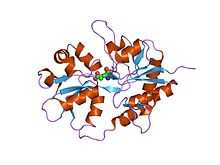Ionotropic glutamate receptor
The ability of synapses to modify their synaptic strength in response to activity is a fundamental property of the nervous system and may be an essential component of learning and memory. There are four classes of ionotropic glutamate receptors, namely NMDA receptor, AMPA receptor, Delta receptor and kainate receptors. They are believed to play critical roles in synaptic plasticity. At many synapses in the brain, transient activation of NMDA receptors leads to a persistent modification in the strength of synaptic transmission mediated by AMPA receptors and kainate receptors can act as the induction trigger for long-term changes in synaptic transmission.[1]
This family includes the four regions of the ionotropic glutamate receptors, i.e. the NMDA, AMPA, Delta receptor and kainate receptors.
Human proteins containing this domain
GRIA1; GRIA2; GRIA3; GRIA4; GRID1; GRID2; GRIK1; GRIK2;
GRIK3; GRIK4; GRIK5; GRIN1; GRIN2A; GRIN2B; GRIN2C; GRIN2D;
GRIN3A; GRIN3B; NR2A;
References
- ↑ Bortolotto ZA, Clarke VR, Delany CM, Parry MC, Smolders I, Vignes M, Ho KH, Miu P, Brinton BT, Fantaske R, Ogden A, Gates M, Ornstein PL, Lodge D, Bleakman D, Collingridge GL (November 1999). "Kainate receptors are involved in synaptic plasticity". Nature 402 (6759): 297–301. doi:10.1038/46290. PMID 10580501.
This article incorporates text from the public domain Pfam and InterPro IPR001320
|
|---|
| | Cys-loop receptors | |
|---|
| | Ionotropic glutamates | Ligand-gated only | |
|---|
| Voltage- and ligand-gated | |
|---|
| ‘Orphan’ | |
|---|
|
|---|
| | ATP-gated channels | |
|---|
| Index of signal transduction |
|---|
| | Description |
- Intercellular
- neuropeptides
- growth factors
- cytokines
- hormones
- Cell surface receptors
- ligand-gated
- enzyme-linked
- G protein-coupled
- immunoglobulin superfamily
- integrins
- neuropeptide
- growth factor
- cytokine
- Intracellular
- adaptor proteins
- GTP-binding
- MAP kinase
- Calcium signaling
- Lipid signaling
- Pathways
- hedgehog
- Wnt
- TGF beta
- MAPK ERK
- notch
- JAK-STAT
- apoptosis
- hippo
- TLR
|
|---|
|
|
Glutamatergics |
|---|
| Receptor
(ligands) | | AMPA | |
|---|
| | NMDA |
- Antagonists: Competitive antagonists: AP5 (APV)
- AP7
- CGP-37849
- CGP-39551
- CGP-39653
- CGP-40116
- CGS-19755
- CPP
- LY-233,053
- LY-235,959
- LY-274,614
- MDL-100,453
- Midafotel (d-CPPene)
- NPC-12,626
- NPC-17,742
- PBPD
- PEAQX
- Perzinfotel
- PPDA
- SDZ-220581
- Selfotel; Noncompetitive antagonists: ARR-15,896
- Caroverine
- Dexanabinol
- FPL-12495
- FR-115,427
- Hodgkinsine
- Magnesium
- MDL-27,266
- NPS-1506
- Psychotridine
- Zinc; Uncompetitive pore blockers: 2-MDP
- 3-MeO-PCP
- 8A-PDHQ
- 18-MC
- α-Endopsychosin
- Alaproclate
- Amantadine
- Aptiganel
- ARL-12,495
- ARL-15,896-AR
- ARL-16,247
- Budipine
- Conaridine
- Delucemine
- Dexoxadrol
- Dextrallorphan
- Dieticyclidine
- Dizocilpine
- Esketamine
- Etoxadrol
- Eticyclidine
- Gacyclidine
- Ibogaine
- Ibogamine
- Indantadol
- Ketamine
- Ketobemidone
- Lanicemine
- Loperamide
- Memantine
- Methadone (Levomethadone)
- Methorphan (Dextromethorphan
- Levomethorphan)
- Methoxetamine
- Methoxphenidine
- Milnacipran
- Morphanol (Dextrorphan
- Levorphanol)
- NEFA
- Neramexane
- Nitromemantine
- Nitrous oxide
- Noribogaine
- Orphenadrine
- PCPr
- Pethidine (meperidine)
- Phencyclamine
- Phencyclidine
- Propoxyphene
- Remacemide
- Rhynchophylline
- Rimantadine
- Rolicyclidine
- Sabeluzole
- Tabernanthine
- Tenocyclidine
- Tiletamine
- Tramadol
- Xenon; Glycine site antagonists: 7-CKA
- ACC
- ACEA-1011
- ACEA-1328
- AV-101
- Carisoprodol
- CGP-39653
- CNQX
- DCKA
- DNQX
- Felbamate
- Gavestinel
- GV-196,771
- Kynurenic acid
- L-689,560
- L-701,324
- Licostinel (ACEA-1021)
- LU-73,068
- MDL-105,519
- Meprobamate
- MRZ 2/576
- PNQX
- ZD-9379; NR2B subunit antagonists: Besonprodil
- CERC-301 (MK-0657)
- CO-101,244 (PD-174,494)
- Eliprodil
- Haloperidol
- Ifenprodil
- Isoxsuprine
- Nylidrin
- Ro8-4304
- Ro25-6981
- Traxoprodil; Polyamine site antagonists: Arcaine
- Co 101676
- Diaminopropane
- Diethylenetriamine
- Huperzine A
- Putrescine
- Ro 25-6981; Unclassified/unsorted antagonists: Bumetanide
- Chloroform
- Cyclopropane
- D-αAA
- Diethyl ether
- Diphenidine
- Enflurane
- Ethanol
- Flufenamic acid
- Flupirtine
- Furosemide
- Halothane
- Isoflurane
- Metaphit
- Methoxyflurane
- Niflumic acid
- Piretanide
- Toluene
- Trichloroethane
- Trichloroethanol
- Trichloroethylene
- Xylene
|
|---|
| | Kainate | |
|---|
| | mGlu1 |
- Antagonists: BAY 36-7620
- CPCCOEt
- LY-367,385
- LY-456,236
- MCPG
- NPS-2390
|
|---|
| | mGlu2 | |
|---|
| | mGlu3 | |
|---|
| | mGlu4 |
- Agonists: Glutamate
- L-AP4
- PHCCC
- VU-001,171
- VU-0155,041; Positive allosteric modulators: MPEP
- Antagonists: CPPG
- MAP4
- MPPG
- MSOP
- MTPG
- UBP-1112
|
|---|
| | mGlu5 | |
|---|
| | mGlu6 |
- Agonists: Glutamate
- L-AP4
- Antagonists: CPPG
- MAP4
- MPPG
- MSOP
- MTPG
- UBP-1112
|
|---|
| | mGlu7 |
- Antagonists: CPPG
- MAP4
- MMPIP
- MPPG
- MSOP
- MTPG
- UBP-1112
|
|---|
| | mGlu8 |
- Antagonists: CPPG
- MAP4
- MPPG
- MSOP
- MTPG
- UBP-1112
|
|---|
|
|---|
| Transporter
(blockers) | |
|---|
| Enzyme
(inhibitors) | | GAH | |
|---|
| | AST |
- 2-Amino-3-butenoic acid
- AAOA
- AMB
- β-DL-Methylene-aspartate
- Hydrazinosuccinate
|
|---|
| | ALT |
- β-Chloro-L-alanine
- L-Cycloserine
- Propargylglycine
|
|---|
| | GDH | |
|---|
| | GS |
- 2-Aminoadipic acid
- JFD01307SC
- Methionine sulfoximine
- Phosphinothricin (glufosinate)
|
|---|
| | GAD | |
|---|
|
|---|
| | Others |
- Cofactors: α-Ketoglutaric acid
- Iron
- Sulfur
- Vitamin B2
- Vitamin B3
|
|---|
| See also: GABAergics • GHBergics • Glycinergics |
|
